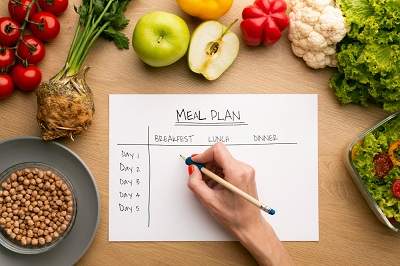In today’s fast-paced world, maintaining a healthy lifestyle while juggling work, family, and personal commitments can seem daunting. Meal planning is a powerful tool that not only simplifies this process but also helps save time, reduce food waste, and promote healthier eating habits. Whether you are a busy professional, a parent, or simply looking to optimize your daily routine, mastering the art of meal planning is a game-changer. In this comprehensive guide, we explore the ins and outs of effective meal planning, offering practical tips and strategies to make your journey smooth and successful.
Why Meal Planning Matters: The Benefits
Meal planning is more than just jotting down meals on a weekly calendar. It’s a systematic approach that brings multiple benefits to your daily life. Below, we highlight some of the key advantages of incorporating meal planning into your routine:
- Time Efficiency: By organizing your meals in advance, you eliminate the last-minute scramble to figure out what’s for dinner. This saves you hours every week, allowing you to spend more time doing what you love.
- Cost Savings: Planned meals mean fewer impulsive grocery store purchases and reduced reliance on takeout, leading to significant savings over time.
- Improved Nutrition: When you plan your meals, you have better control over ingredients, portion sizes, and the nutritional value of each dish.
- Reduced Food Waste: Knowing exactly what you need allows you to buy only what you’ll use, minimizing spoilage and waste.
- Stress Reduction: With a solid meal plan, the daily question of “What’s for dinner?” becomes a thing of the past. You’ll approach each day with confidence and peace of mind.
Getting Started with Meal Planning: Essential Tips
Starting with meal planning may seem overwhelming at first, but with the right approach, it becomes a seamless and enjoyable process. Here’s how to set yourself up for success:
Assess Your Needs and Goals
Before diving into meal planning, it’s essential to understand your specific needs and objectives. Consider the following:
- Dietary Restrictions: Do you have any food allergies or dietary preferences such as gluten-free, vegetarian, or low-carb?
- Nutritional Goals: Are you looking to lose weight, gain muscle, or simply eat a balanced diet?
- Time Constraints: How much time can you realistically dedicate to cooking each day?
Start with a Weekly Meal Planning Template
A weekly meal planning template is a visual tool that helps you outline your meals for the week. Start by assigning meals to specific days and incorporate leftovers where appropriate. Make sure to plan for breakfast, lunch, dinner, and snacks to avoid any unplanned eating.
Create a Master List of Favorite Recipes
Compile a list of go-to recipes that are both nutritious and easy to prepare. Having a master list makes it easier to mix and match dishes each week. Categorize them into different meal types—such as quick dinners, meal-prep lunches, and healthy snacks—so you can easily pull from them when building your weekly plan.
Choose a Shopping Day and Stick to It
Set aside one day each week to do your grocery shopping based on your meal plan. This ensures that you have everything you need and prevents mid-week trips that lead to unnecessary purchases.
Smart Strategies for Successful Meal Planning
Use Theme Nights to Simplify Planning
Assigning themes to each day of the week can add structure to your meal plan. For example:
- Meatless Monday: Focus on vegetarian or vegan dishes.
- Taco Tuesday: Experiment with different taco recipes.
- Stir-Fry Wednesday: Use this day for quick and healthy stir-fries.
- Slow-Cooker Thursday: Let a slow cooker or Instant Pot do the work for you.
Batch Cooking and Freezing
Batch cooking involves preparing larger quantities of certain dishes so you can freeze individual portions for future meals. Ideal recipes for batch cooking include soups, stews, casseroles, and pasta dishes. Simply portion them into meal-sized containers and freeze, making them easy to thaw and reheat on busy days.
Prioritize Nutrient-Dense Ingredients
Focus on ingredients that are rich in essential nutrients. Aim to include a variety of vegetables, lean proteins, whole grains, and healthy fats in your meal plan. Choose seasonal produce whenever possible, as it’s often fresher and more affordable.
Utilize Pre-Chopped Vegetables and Ready-Made Staples
To streamline meal prep, take advantage of pre-chopped vegetables, canned beans, and other convenience items that fit your dietary guidelines. This reduces prep time and encourages you to cook at home more often.
Meal Planning for Different Lifestyles
Meal Planning for Families
When planning meals for a family, it’s important to accommodate diverse tastes and dietary needs. Consider involving family members in the planning process by letting them choose a meal for the week. This not only empowers them but also reduces the likelihood of meal-time complaints.
For busy families, focus on recipes that can be prepped in advance and stored for several days, such as casseroles, sheet-pan dinners, and one-pot meals. Leftovers can also be repurposed into new dishes—think roasted chicken turned into chicken salad or stir-fried vegetables transformed into a hearty soup.
Meal Planning for Weight Management
If your goal is weight management, portion control and calorie tracking are key. Use your meal plan to map out balanced meals that align with your calorie and macronutrient goals. Consider using a meal planning app to easily calculate the nutritional information of each dish.
Additionally, include plenty of high-fiber foods like fruits, vegetables, and whole grains, which help keep you full and satisfied.
Meal Planning for Vegetarians and Vegans
Vegetarians and vegans should ensure that their meal plans provide sufficient protein, iron, calcium, and vitamin B12. Incorporate a variety of plant-based protein sources, such as lentils, chickpeas, tofu, tempeh, and quinoa.
Meal Planning for Athletes
Athletes require meal plans that support high-energy demands and muscle recovery. Include complex carbohydrates, lean proteins, and healthy fats in every meal. Timing is also crucial; schedule meals and snacks around workouts to optimize performance and recovery.
Top Tools and Resources for Effective Meal Planning
To simplify the meal planning process, take advantage of the following tools:
- Meal Planning Apps: Use apps like MyFitnessPal, Yummly, or Paprika to organize your meal plans and track nutrition.
- Recipe Websites: Explore websites like AllRecipes, Food Network, or Minimalist Baker for inspiration.
- Meal Prep Containers: Invest in quality containers to store and organize your meals for the week.
- Grocery Delivery Services: Consider using grocery delivery services to save time and ensure you have everything you need without leaving home.
Overcoming Common Meal Planning Challenges
Lack of Time
If time is a major constraint, focus on recipes with minimal prep and cook time. Consider using a slow cooker, pressure cooker, or meal delivery kits to speed up the process.
Picky Eaters
For picky eaters, try to include familiar ingredients and gradually introduce new foods. Offer customizable meal options, like build-your-own bowls or tacos, to cater to different preferences.
Sticking to the Plan
If sticking to the plan is challenging, be flexible. Swap meals around as needed and keep a few quick options, like frozen vegetables and pantry staples, on hand for busy days.
Conclusion
Meal planning is a versatile and effective strategy for saving time, improving health, and reducing stress. The key is to start simple and build your meal planning skills over time. As you become more comfortable, experiment with new recipes, techniques, and meal prep strategies to find what works best for your lifestyle.




